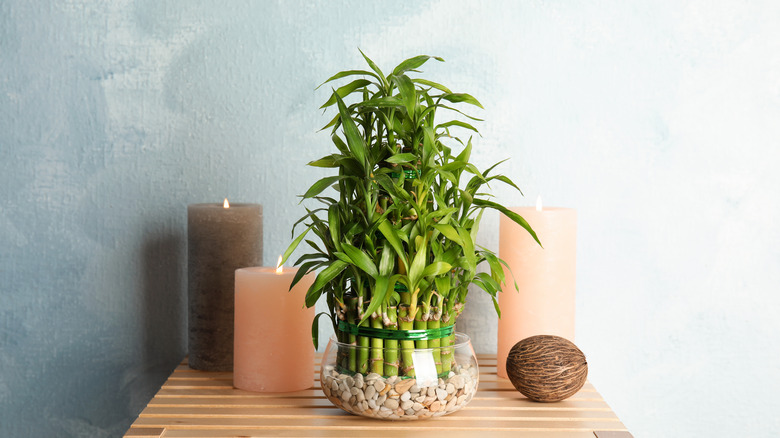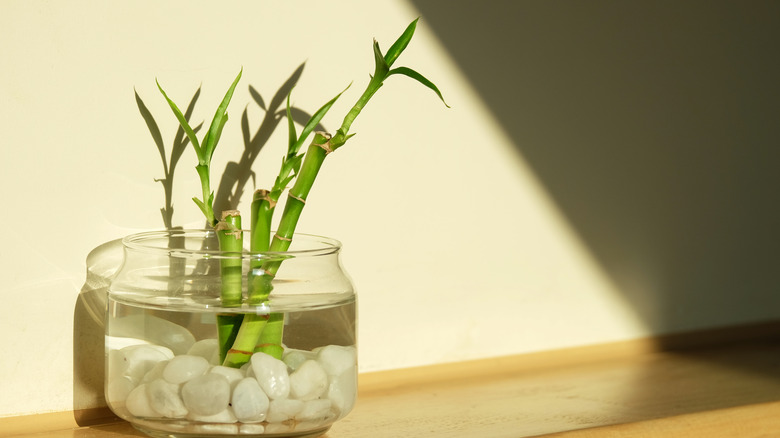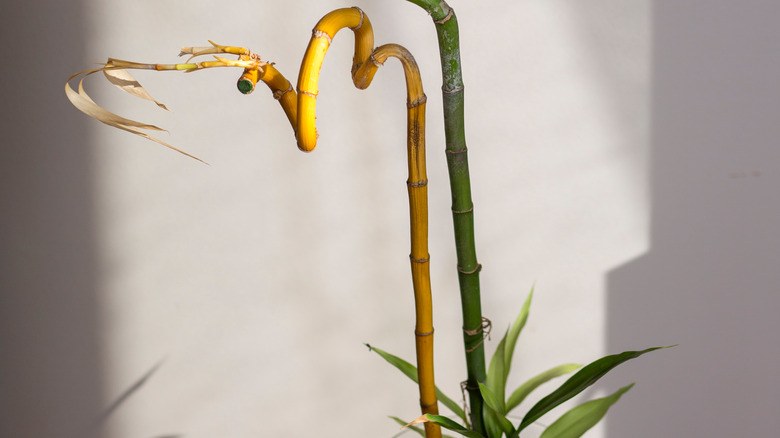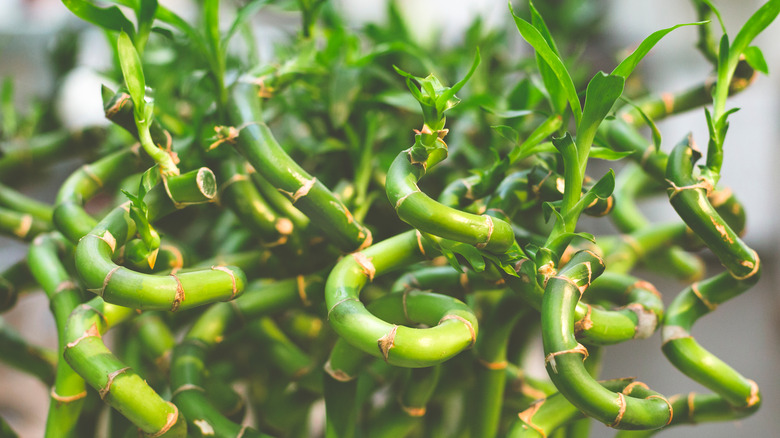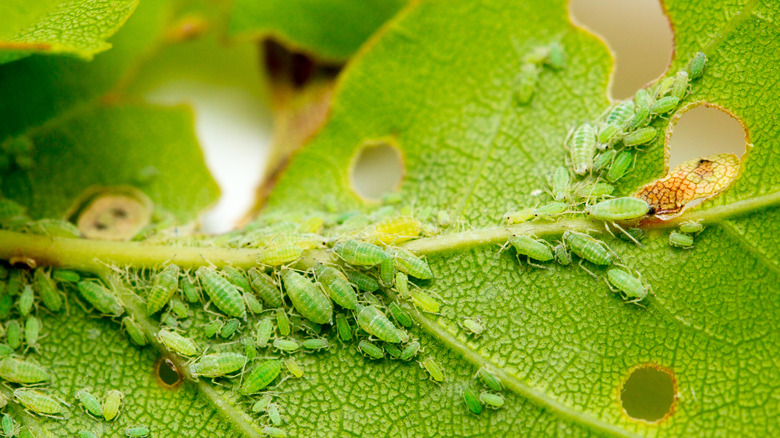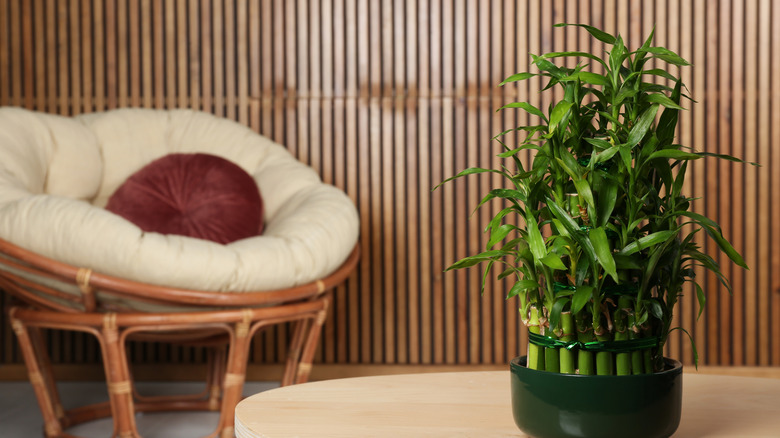Telltale Signs Your Lucky Bamboo Plants Are In Trouble
Lucky bamboo can be the perfect plant to spruce up your home. It's fresh and vibrant, and Garden Guides details that it's one of the easiest, most low-maintenance plants that you can keep. Many people assume that due to its colloquial name, lucky bamboo is a species of bamboo. However, Fernsnpetals explains that it's actually a type of tropical water lily and its formal name is Dracaena Sanderiana. Given the right care and attention, your lucky bamboo can thrive.
Flower Shop Network explains that lucky bamboo is a really popular choice of plant because it doesn't just look incredibly aesthetically pleasing on Instagram; Dracaena Sanderiana is super versatile and great for first-time plant owners. All you have to do is work out when you're going to water it, do so consistently, and make sure it's sat in a sunny spot. They can grow in soil or water, and once you've got their basic needs taken care of, they bloom.
It can be difficult to spot the initial signs that your lucky bamboo is in trouble, especially if you're only taking a good look at it every time you water it. However, there are some clear signs when something isn't right. To that end, here are some of the telltale signs that your lucky bamboo plants are in trouble. Knowing what they are can help you save your plant before it dies.
Your lucky bamboo plant is drooping
One of the reasons that lucky bamboo is such a popular option in homes is that it blooms and grows leaves pretty quickly under the right conditions. Your plant should stand tall. So, Flower Shop Network highlights that if you notice that the leaves on your lucky bamboo plant begin to droop that it may be indicative of a bigger issue; if the whole plant is wilting or leaning, then you will need to investigate.
Houzz outlines that, from stalk to leaf, your lucky bamboo plant should be able to stand tall independently. If it starts to wilt then you need to water it as soon as possible. Lucky bamboo can grow in water, and that's a convenient way of ensuring that it's getting all of the hydration and nutrients it needs.
Bamboo plants grow in multiple layers. Fernsnpetals explains that yours may have two, three, or even seven layers. Catching drooping early could mean that you save the rest of the plant from suffering.
The leaves of your lucky bamboo plant turn yellow or brown
Another really clear sign that your lucky bamboo plant is in trouble is if the leaves have turned yellow or brown. Healthy lucky bamboo is a vibrant green, and it should be supple and flexible. However, Love To Know points out that if it becomes yellow or beige, dry to the touch, and breaks easily, then it could indicate that your plant has a disease, there's an issue with the fertilizer you've used, it's not getting the right amount of water or light, or the temperature it's sitting in isn't suitable.
SF Gate explains that while it might be tempting to dwell on your discolored lucky bamboo and try and find a quick fix, the best thing you can do in this situation is try and find the root cause and nip that issue in the bud. Hunker adds that this may mean changing the container that your lucky bamboo sits in or placing it in water instead of soil. You might consider relocating your lucky bamboo to a warmer, sunnier spot in your home. However, you want to ensure that direct sunlight isn't hitting your lucky bamboo. To keep an eye on your lucky bamboo you should check it once a week, even if it's growing in water, to ensure that it looks and feels healthy.
The stalk of your lucky bamboo plant looks thin or spindly
Within reason, lucky bamboo is a pretty robust plant, as the stalks are thick and flexible. To that end, however, the leaves aren't the only parts of a lucky bamboo plant that can indicate that something may be wrong. SF Gate explains that if the stem of your lucky bamboo has become thin, spindly, or yellow then it's a pretty major issue for the plant. At this point, you should cut the plant back to the point where the stalk looks soft or thin and attempt to regrow the plant from that point.
Lucky bamboo plants are incredibly pretty as their stalks spiral, curl, and grow in different directions. However, they should be able to hold their shape in growth. Love To Know notes that if the stalk of your lucky bamboo has discolored or become weak, then it's more than likely that the leaves have already turned yellow or brown and the plant has drooped. And if the stalk is very soft or spindly, then Garden Guides explains that your plant may have already died.
Your lucky bamboo plant has spots
While the leaves and stalk of your lucky bamboo plant may not have discolored, the Flower Shop Network explains that it may develop spots or lesions on their leaves. Different colored spots and holes can be caused by different things, but the publication notes that it's usually indicative of infection or fungus. Small brown spots can be caused by Phyllosticta Maculicola, an issue that can be made worse by water. Fusarium Leaf Spot may also be the culprit. If you're unsure of the issue, then take your plant to your local nursery. An expert should be able to tell you exactly what is wrong.
As spotting is usually an indicator of infection, it's common practice to trim the areas of your plant that have already been affected to save the rest of your lucky bamboo plant. You can do this with clippers so as not to damage the rest of the plant.
You can save your lucky bamboo plant
If you notice any of the above issues with your lucky bamboo plant, take heart: It doesn't automatically mean that you should get rid of it and buy a new one. Fortunately, there are so many ways to remedy any issues. Hunker outlines that finding the right spot for your lucky bamboo plant is the first port of call in ensuring that it'll be able to thrive. The plants need sun but not direct sunlight, so a windowsill is not the best option. They also don't cope well in cold or drafty conditions; you want to maintain a temperature of around 65 to 85 degrees.
Love To Know also explains that you should also reassess how you water your lucky bamboo. You should water your plant two or three times a week with clean water. If your plant is growing in water, then change it every week. You want to ensure that its roots are submerged at all times. Still, overwatering is just as bad as underwatering it. Lastly, SF Gate explains that fertilizer may be the root cause of your problems; overfertilization may be the thing that's triggering issues within your bamboo plant. If all else fails you can trim back the damaged parts of your lucky bamboo plant in the hope that it grows back healthier.
Seeing a beloved plant wilt and discolor can be so disheartening. However, there are so many ways to revive a lucky bamboo.
